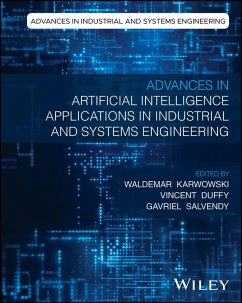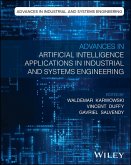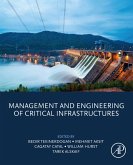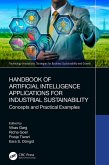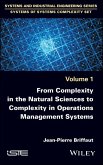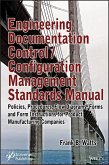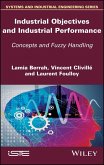Advances in Artificial Intelligence Applications in Industrial and Systems Engineering (eBook, ePUB)
Redaktion: Karwowski, Waldemar; Salvendy, Gavriel; Duffy, Vincent
100,99 €
100,99 €
inkl. MwSt.
Sofort per Download lieferbar

0 °P sammeln
100,99 €
Als Download kaufen

100,99 €
inkl. MwSt.
Sofort per Download lieferbar

0 °P sammeln
Jetzt verschenken
Alle Infos zum eBook verschenken
100,99 €
inkl. MwSt.
Sofort per Download lieferbar
Alle Infos zum eBook verschenken

0 °P sammeln
Advances in Artificial Intelligence Applications in Industrial and Systems Engineering (eBook, ePUB)
Redaktion: Karwowski, Waldemar; Salvendy, Gavriel; Duffy, Vincent
- Format: ePub
- Merkliste
- Auf die Merkliste
- Bewerten Bewerten
- Teilen
- Produkt teilen
- Produkterinnerung
- Produkterinnerung

Bitte loggen Sie sich zunächst in Ihr Kundenkonto ein oder registrieren Sie sich bei
bücher.de, um das eBook-Abo tolino select nutzen zu können.
Hier können Sie sich einloggen
Hier können Sie sich einloggen
Sie sind bereits eingeloggt. Klicken Sie auf 2. tolino select Abo, um fortzufahren.

Bitte loggen Sie sich zunächst in Ihr Kundenkonto ein oder registrieren Sie sich bei bücher.de, um das eBook-Abo tolino select nutzen zu können.
Comprehensive guide offering actionable strategies for enhancing human-centered AI, efficiency, and productivity in industrial and systems engineering through the power of AI.
Advances in Artificial Intelligence Applications in Industrial and Systems Engineering is the first book in the Advances in Industrial and Systems Engineering series, offering insights into AI techniques, challenges, and applications across various industrial and systems engineering (ISE) domains. Not only does the book chart current AI trends and tools for effective integration, but it also raises pivotal ethical…mehr
- Geräte: eReader
- mit Kopierschutz
- eBook Hilfe
- Größe: 6.98MB
Andere Kunden interessierten sich auch für
![Advances in Artificial Intelligence Applications in Industrial and Systems Engineering (eBook, PDF) Advances in Artificial Intelligence Applications in Industrial and Systems Engineering (eBook, PDF)]() Advances in Artificial Intelligence Applications in Industrial and Systems Engineering (eBook, PDF)100,99 €
Advances in Artificial Intelligence Applications in Industrial and Systems Engineering (eBook, PDF)100,99 €![Management and Engineering of Critical Infrastructures (eBook, ePUB) Management and Engineering of Critical Infrastructures (eBook, ePUB)]() Management and Engineering of Critical Infrastructures (eBook, ePUB)95,95 €
Management and Engineering of Critical Infrastructures (eBook, ePUB)95,95 €![Handbook of Artificial Intelligence Applications for Industrial Sustainability (eBook, ePUB) Handbook of Artificial Intelligence Applications for Industrial Sustainability (eBook, ePUB)]() Handbook of Artificial Intelligence Applications for Industrial Sustainability (eBook, ePUB)167,95 €
Handbook of Artificial Intelligence Applications for Industrial Sustainability (eBook, ePUB)167,95 €![Analysis, Modeling and Stability of Fractional Order Differential Systems 2 (eBook, ePUB) Analysis, Modeling and Stability of Fractional Order Differential Systems 2 (eBook, ePUB)]() Jean-Claude TrigeassouAnalysis, Modeling and Stability of Fractional Order Differential Systems 2 (eBook, ePUB)139,99 €
Jean-Claude TrigeassouAnalysis, Modeling and Stability of Fractional Order Differential Systems 2 (eBook, ePUB)139,99 €![From Complexity in the Natural Sciences to Complexity in Operations Management Systems (eBook, ePUB) From Complexity in the Natural Sciences to Complexity in Operations Management Systems (eBook, ePUB)]() Jean-Pierre BriffautFrom Complexity in the Natural Sciences to Complexity in Operations Management Systems (eBook, ePUB)139,99 €
Jean-Pierre BriffautFrom Complexity in the Natural Sciences to Complexity in Operations Management Systems (eBook, ePUB)139,99 €![Engineering Documentation Control / Configuration Management Standards Manual (eBook, ePUB) Engineering Documentation Control / Configuration Management Standards Manual (eBook, ePUB)]() Frank B. WattsEngineering Documentation Control / Configuration Management Standards Manual (eBook, ePUB)170,99 €
Frank B. WattsEngineering Documentation Control / Configuration Management Standards Manual (eBook, ePUB)170,99 €![Industrial Objectives and Industrial Performance (eBook, ePUB) Industrial Objectives and Industrial Performance (eBook, ePUB)]() Lamia BerrahIndustrial Objectives and Industrial Performance (eBook, ePUB)139,99 €
Lamia BerrahIndustrial Objectives and Industrial Performance (eBook, ePUB)139,99 €-
-
-
Comprehensive guide offering actionable strategies for enhancing human-centered AI, efficiency, and productivity in industrial and systems engineering through the power of AI.
Advances in Artificial Intelligence Applications in Industrial and Systems Engineering is the first book in the Advances in Industrial and Systems Engineering series, offering insights into AI techniques, challenges, and applications across various industrial and systems engineering (ISE) domains. Not only does the book chart current AI trends and tools for effective integration, but it also raises pivotal ethical concerns and explores the latest methodologies, tools, and real-world examples relevant to today's dynamic ISE landscape.
Readers will gain a practical toolkit for effective integration and utilization of AI in system design and operation. The book also presents the current state of AI across big data analytics, machine learning, artificial intelligence tools, cloud-based AI applications, neural-based technologies, modeling and simulation in the metaverse, intelligent systems engineering, and more, and discusses future trends.
Written by renowned international contributors for an international audience, Advances in Artificial Intelligence Applications in Industrial and Systems Engineering includes information on:
Advances in Artificial Intelligence Applications in Industrial and Systems Engineering is a timely, essential reference for engineering, computer science, and business professionals worldwide.
Advances in Artificial Intelligence Applications in Industrial and Systems Engineering is the first book in the Advances in Industrial and Systems Engineering series, offering insights into AI techniques, challenges, and applications across various industrial and systems engineering (ISE) domains. Not only does the book chart current AI trends and tools for effective integration, but it also raises pivotal ethical concerns and explores the latest methodologies, tools, and real-world examples relevant to today's dynamic ISE landscape.
Readers will gain a practical toolkit for effective integration and utilization of AI in system design and operation. The book also presents the current state of AI across big data analytics, machine learning, artificial intelligence tools, cloud-based AI applications, neural-based technologies, modeling and simulation in the metaverse, intelligent systems engineering, and more, and discusses future trends.
Written by renowned international contributors for an international audience, Advances in Artificial Intelligence Applications in Industrial and Systems Engineering includes information on:
- Reinforcement learning, computer vision and perception, and safety considerations for autonomous systems (AS)
- (NLP) topics including language understanding and generation, sentiment analysis and text classification, and machine translation
- AI in healthcare, covering medical imaging and diagnostics, drug discovery and personalized medicine, and patient monitoring and predictive analysis
- Cybersecurity, covering threat detection and intrusion prevention, fraud detection and risk management, and network security
- Social good applications including poverty alleviation and education, environmental sustainability, and disaster response and humanitarian aid.
Advances in Artificial Intelligence Applications in Industrial and Systems Engineering is a timely, essential reference for engineering, computer science, and business professionals worldwide.
Dieser Download kann aus rechtlichen Gründen nur mit Rechnungsadresse in D ausgeliefert werden.
Produktdetails
- Produktdetails
- Verlag: John Wiley & Sons
- Seitenzahl: 787
- Erscheinungstermin: 15. August 2025
- Englisch
- ISBN-13: 9781394257072
- Artikelnr.: 75220023
- Verlag: John Wiley & Sons
- Seitenzahl: 787
- Erscheinungstermin: 15. August 2025
- Englisch
- ISBN-13: 9781394257072
- Artikelnr.: 75220023
- Herstellerkennzeichnung Die Herstellerinformationen sind derzeit nicht verfügbar.
WALDEMAR KARWOWSKI is a Pegasus Professor and Chair in the Department of Industrial Engineering and Management Systems at the University of Central Florida. He is an elected member of The Academy of Science, Engineering and Medicine of Florida (ASEMFL). VINCENT DUFFY is a Professor of Industrial Engineering and Agricultural & Biological Engineering at Purdue University and a Fulbright Senior Scholar. GAVRIEL SALVENDY is a University Distinguished Professor at the University of Central Florida, a member of the National Academy of Engineering, and founding Department Head of Industrial Engineering at Tsinghua University in China.
About the Editors xxiii
Preface xxv
1 Introduction to Industrial Artificial Intelligence 1
Dai-Yan Ji, Hanqi Su, Takanobu Minami, and Jay Lee, USA
1.1 Fundamental Problems in Industry 1
1.2 The Purpose of Industrial AI 2
1.3 Difference Between AI and Industrial AI 4
1.4 Definition and Meaning of Industrial AI 5
1.5 Key Elements in Industrial AI: ABCDE 7
1.6 CPS Framework for Industrial AI 8
1.7 Technological Elements of CPS Framework 9
1.8 Developing Industrial AI Talents 10
1.9 Training Industrial AI Talents Using Open-source Datasets 10
1.10 Issues in Industrial AI 14
1.11 Conclusion 16
2 Autonomous Systems and Intelligent Agents 19
Babak Ebrahimi Soorchaei, Arash Raftari, and Yaser Fallah, USA
2.1 Definitions and Scopes 19
2.2 Core Concepts and Components 21
2.3 Applications and Case Study: Autonomous Vehicle 27
2.4 Challenges and Future Directions 37
3 Natural Language Processing for Industrial and Systems Engineering 43
Daniel Braun, Germany
3.1 Introduction 43
3.2 Advances and Trends in NLP 44
3.3 Domain-specific Challenges in ISE 47
3.4 Applications of NLP in ISE 50
3.5 Outlook 52
4 Smart Manufacturing, Robotics, and AI Systems 61
Xifan Yao, Huifeng Yan, Jiajun Zhou, Yongxiang Li, and Hongnian Yu,
China/UK
4.1 Introduction to Smart Manufacturing 61
4.2 Smart Manufacturing System Integration and Interoperability 63
4.3 Robotics in Manufacturing 67
4.4 AI in Manufacturing 70
5 Artificial Intelligence in Healthcare 79
Vinita Gangaram Jansari, USA
5.1 History of Artificial Intelligence in Healthcare 79
5.2 New Age of Healthcare with the Use of AI 81
5.3 AI-enabled Medical Devices 85
5.4 Explainable AI for Healthcare 86
5.5 Medical Decision Support Systems 87
5.6 Precision/Personalized Medicine Using AI 88
5.7 Smart Healthcare 89
5.8 Healthcare 5.0 90
5.9 Ethics, Bias, and Fairness Constraints 94
5.10 Concluding Remarks 96
5.11 Future Directions 96
6 Artificial Intelligence in Cybersecurity for Industrial and Systems
Engineering 111
Robin Yeman, Hasan Yasar, Suzette Johnson, and Tracy Bannon, USA
6.1 Introduction to Cybersecurity and Artificial Intelligence for
Industrial and Systems Engineering 111
6.2 Cyber Threat Landscape for CPS 113
6.3 AI in Cybersecurity for CPS 113
6.4 Risk Assessment, Compliance, and Regulatory Considerations 115
6.5 Threat Detection and Prevention 116
6.6 Incident Response and Management 118
6.7 Anti-phishing 120
6.8 Dependable Authentication 120
6.9 Behavior Analytics 121
6.10 Conclusion 121
7 Artificial Intelligence in Defense 125
Dylan Schmorrow, Robert Sottilare, Jack Zaientz, John Sauter, Randolph
Jones, Charles Newton, Joseph Cohn, Jon Sussman-Fort, Robert Bixler, Brice
Colby, Victor Hung, Jeffrey Craighead, Le Nguyen, and Ullice Pelican, USA
7.1 Introduction 125
7.2 Ethical Considerations and Challenges 126
7.3 AI-driven Innovations in C2 Systems 129
7.4 AI Applications in Uncrewed Systems 132
7.5 Application of AI to Cyber Operations 134
7.6 AI-enabled Training and Simulation Systems 137
7.7 AI-enabled HMI Technologies 143
7.8 Integrating Machine Reasoning and Explanation for Dynamic
Decision-making 146
7.9 Responsible AI in Predictive Systems and Medical/Defense Health
Readiness 148
7.10 Future Directions 150
7.11 Conclusion 154
8 AI-Driven Management and Modeling Decision Optimization as a Timely
Opportunity at the US Department of Defense 159
Link Parikh, USA
8.1 Why Act Now and Why Engineering Lifecycle and AI? 159
8.2 Who Needs to Make Changes in the Ecosystem? 163
8.3 How to Implement the AI-driven Ecosystems Management and Modeling
Regime 167
8.4 Key Elements of AI-driven Ecosystem Management and Modeling 169
8.5 Enhance Workforce Development and Mentorship 178
8.6 When Can We Acquire Dramatic Speed and Precision? 179
8.7 Which Elements Exist in "AI Ecosystem Management and Modeling?" 179
8.8 Sample Applications of Dramatic Speed and Precision 191
8.9 AI-driven Ecosystem Management and Modeling Solution and Toolset 192
8.10 Summary 194
9 Enhancing Cryptocurrency Market Forecasting: Advanced Machine Learning
Techniques and Industrial Engineering Contributions 197
Jannatun Nayeem Pinky and Ramya Akula, USA
9.1 Introduction 197
9.2 Background 199
9.3 Methods 201
9.4 Dataset 224
9.5 Evaluation 236
9.6 Limitations 253
9.7 Future Recommendations 254
9.8 Conclusion 257
10 Artificial Intelligence in Aviation 263
Dr. Dimitrios Ziakkas, USA
10.1 Introduction to Artificial Intelligence in Aviation 263
10.2 AI in Flight Operations and Training 264
10.3 AI in Air Traffic Management 267
10.4 AI in Airport Operations 268
10.5 AI in Customer Experience and Service 270
10.6 AI in Maintenance and Technical Support 272
10.7 Human Factors and AI Integration 274
10.8 Ethical and Regulatory Challenges 275
10.9 AI Case Studies and Future Prospects 276
10.10 The Future of AI in Aviation 278
11 Enhancing Engineering Education: A Multimodal Approach to
Personalization and Adaptation Using Artificial Intelligence in Game-based
Learning 281
Roger Azevedo, Daryn Dever, and Megan Wiedbusch, USA
11.1 Context: Challenges in Engineering Education 281
11.2 GBLEs for Engineering Education: Are They Effective? 283
11.3 Personalization and Adaptivity in GBLEs 284
11.4 Personalization and Adaptivity in GBLEs for Engineering Education: Are
They Effective? 284
11.5 Augmenting Personalization and Adaptivity in GBLEs in Engineering
Education with Multimodal Trace Data
286
11.6 AI Techniques for Handling Multimodal Approaches to Individualization
and Adaptation 288
11.7 Essential SRL Processes from Multimodal Trace Data with GBLEs in
Engineering Education 289
11.8 Open Questions, Future Directions, and Conclusions 297
12 Securing Artificial Intelligence Systems in the Era of Large Language
Models 307
Carmen-Gabriela Stefanita, USA
12.1 The Need for an Artificial Intelligence Risk Management Framework in
an Evolving Artificial Intelligence Landscape 307
12.2 Security for AI Threat Model 313
12.3 Implementing a Security for AI Framework 317
12.4 Conclusion 323
13 Responsible Artificial Intelligence Applications for Social Good 327
Ozlem Garibay and Brent Winslow, USA
13.1 Introduction 327
13.2 Ethical Aspects of AI for Social Good Applications 328
13.3 AI Applications for Healthcare 331
13.4 AI for Environmental Sustainability 335
13.5 AI for Education and Accessibility 338
13.6 AI in Humanitarian Efforts and Disaster Response 340
13.7 Conclusion 342
14 Future Directions and Applications of Artificial Intelligence 355
Ivan Garibay, Clayton Barham, Sina Abdidizaji, Chathura Jayalath, USA
14.1 Introduction 355
14.2 Emerging Trends of AI for Industrial Engineering 356
14.3 Recent Applications 360
14.4 Future Directions: Explainable AI for Industrial Engineering 361
14.5 Case Study 365
References 366
Index 371
Preface xxv
1 Introduction to Industrial Artificial Intelligence 1
Dai-Yan Ji, Hanqi Su, Takanobu Minami, and Jay Lee, USA
1.1 Fundamental Problems in Industry 1
1.2 The Purpose of Industrial AI 2
1.3 Difference Between AI and Industrial AI 4
1.4 Definition and Meaning of Industrial AI 5
1.5 Key Elements in Industrial AI: ABCDE 7
1.6 CPS Framework for Industrial AI 8
1.7 Technological Elements of CPS Framework 9
1.8 Developing Industrial AI Talents 10
1.9 Training Industrial AI Talents Using Open-source Datasets 10
1.10 Issues in Industrial AI 14
1.11 Conclusion 16
2 Autonomous Systems and Intelligent Agents 19
Babak Ebrahimi Soorchaei, Arash Raftari, and Yaser Fallah, USA
2.1 Definitions and Scopes 19
2.2 Core Concepts and Components 21
2.3 Applications and Case Study: Autonomous Vehicle 27
2.4 Challenges and Future Directions 37
3 Natural Language Processing for Industrial and Systems Engineering 43
Daniel Braun, Germany
3.1 Introduction 43
3.2 Advances and Trends in NLP 44
3.3 Domain-specific Challenges in ISE 47
3.4 Applications of NLP in ISE 50
3.5 Outlook 52
4 Smart Manufacturing, Robotics, and AI Systems 61
Xifan Yao, Huifeng Yan, Jiajun Zhou, Yongxiang Li, and Hongnian Yu,
China/UK
4.1 Introduction to Smart Manufacturing 61
4.2 Smart Manufacturing System Integration and Interoperability 63
4.3 Robotics in Manufacturing 67
4.4 AI in Manufacturing 70
5 Artificial Intelligence in Healthcare 79
Vinita Gangaram Jansari, USA
5.1 History of Artificial Intelligence in Healthcare 79
5.2 New Age of Healthcare with the Use of AI 81
5.3 AI-enabled Medical Devices 85
5.4 Explainable AI for Healthcare 86
5.5 Medical Decision Support Systems 87
5.6 Precision/Personalized Medicine Using AI 88
5.7 Smart Healthcare 89
5.8 Healthcare 5.0 90
5.9 Ethics, Bias, and Fairness Constraints 94
5.10 Concluding Remarks 96
5.11 Future Directions 96
6 Artificial Intelligence in Cybersecurity for Industrial and Systems
Engineering 111
Robin Yeman, Hasan Yasar, Suzette Johnson, and Tracy Bannon, USA
6.1 Introduction to Cybersecurity and Artificial Intelligence for
Industrial and Systems Engineering 111
6.2 Cyber Threat Landscape for CPS 113
6.3 AI in Cybersecurity for CPS 113
6.4 Risk Assessment, Compliance, and Regulatory Considerations 115
6.5 Threat Detection and Prevention 116
6.6 Incident Response and Management 118
6.7 Anti-phishing 120
6.8 Dependable Authentication 120
6.9 Behavior Analytics 121
6.10 Conclusion 121
7 Artificial Intelligence in Defense 125
Dylan Schmorrow, Robert Sottilare, Jack Zaientz, John Sauter, Randolph
Jones, Charles Newton, Joseph Cohn, Jon Sussman-Fort, Robert Bixler, Brice
Colby, Victor Hung, Jeffrey Craighead, Le Nguyen, and Ullice Pelican, USA
7.1 Introduction 125
7.2 Ethical Considerations and Challenges 126
7.3 AI-driven Innovations in C2 Systems 129
7.4 AI Applications in Uncrewed Systems 132
7.5 Application of AI to Cyber Operations 134
7.6 AI-enabled Training and Simulation Systems 137
7.7 AI-enabled HMI Technologies 143
7.8 Integrating Machine Reasoning and Explanation for Dynamic
Decision-making 146
7.9 Responsible AI in Predictive Systems and Medical/Defense Health
Readiness 148
7.10 Future Directions 150
7.11 Conclusion 154
8 AI-Driven Management and Modeling Decision Optimization as a Timely
Opportunity at the US Department of Defense 159
Link Parikh, USA
8.1 Why Act Now and Why Engineering Lifecycle and AI? 159
8.2 Who Needs to Make Changes in the Ecosystem? 163
8.3 How to Implement the AI-driven Ecosystems Management and Modeling
Regime 167
8.4 Key Elements of AI-driven Ecosystem Management and Modeling 169
8.5 Enhance Workforce Development and Mentorship 178
8.6 When Can We Acquire Dramatic Speed and Precision? 179
8.7 Which Elements Exist in "AI Ecosystem Management and Modeling?" 179
8.8 Sample Applications of Dramatic Speed and Precision 191
8.9 AI-driven Ecosystem Management and Modeling Solution and Toolset 192
8.10 Summary 194
9 Enhancing Cryptocurrency Market Forecasting: Advanced Machine Learning
Techniques and Industrial Engineering Contributions 197
Jannatun Nayeem Pinky and Ramya Akula, USA
9.1 Introduction 197
9.2 Background 199
9.3 Methods 201
9.4 Dataset 224
9.5 Evaluation 236
9.6 Limitations 253
9.7 Future Recommendations 254
9.8 Conclusion 257
10 Artificial Intelligence in Aviation 263
Dr. Dimitrios Ziakkas, USA
10.1 Introduction to Artificial Intelligence in Aviation 263
10.2 AI in Flight Operations and Training 264
10.3 AI in Air Traffic Management 267
10.4 AI in Airport Operations 268
10.5 AI in Customer Experience and Service 270
10.6 AI in Maintenance and Technical Support 272
10.7 Human Factors and AI Integration 274
10.8 Ethical and Regulatory Challenges 275
10.9 AI Case Studies and Future Prospects 276
10.10 The Future of AI in Aviation 278
11 Enhancing Engineering Education: A Multimodal Approach to
Personalization and Adaptation Using Artificial Intelligence in Game-based
Learning 281
Roger Azevedo, Daryn Dever, and Megan Wiedbusch, USA
11.1 Context: Challenges in Engineering Education 281
11.2 GBLEs for Engineering Education: Are They Effective? 283
11.3 Personalization and Adaptivity in GBLEs 284
11.4 Personalization and Adaptivity in GBLEs for Engineering Education: Are
They Effective? 284
11.5 Augmenting Personalization and Adaptivity in GBLEs in Engineering
Education with Multimodal Trace Data
286
11.6 AI Techniques for Handling Multimodal Approaches to Individualization
and Adaptation 288
11.7 Essential SRL Processes from Multimodal Trace Data with GBLEs in
Engineering Education 289
11.8 Open Questions, Future Directions, and Conclusions 297
12 Securing Artificial Intelligence Systems in the Era of Large Language
Models 307
Carmen-Gabriela Stefanita, USA
12.1 The Need for an Artificial Intelligence Risk Management Framework in
an Evolving Artificial Intelligence Landscape 307
12.2 Security for AI Threat Model 313
12.3 Implementing a Security for AI Framework 317
12.4 Conclusion 323
13 Responsible Artificial Intelligence Applications for Social Good 327
Ozlem Garibay and Brent Winslow, USA
13.1 Introduction 327
13.2 Ethical Aspects of AI for Social Good Applications 328
13.3 AI Applications for Healthcare 331
13.4 AI for Environmental Sustainability 335
13.5 AI for Education and Accessibility 338
13.6 AI in Humanitarian Efforts and Disaster Response 340
13.7 Conclusion 342
14 Future Directions and Applications of Artificial Intelligence 355
Ivan Garibay, Clayton Barham, Sina Abdidizaji, Chathura Jayalath, USA
14.1 Introduction 355
14.2 Emerging Trends of AI for Industrial Engineering 356
14.3 Recent Applications 360
14.4 Future Directions: Explainable AI for Industrial Engineering 361
14.5 Case Study 365
References 366
Index 371
About the Editors xxiii
Preface xxv
1 Introduction to Industrial Artificial Intelligence 1
Dai-Yan Ji, Hanqi Su, Takanobu Minami, and Jay Lee, USA
1.1 Fundamental Problems in Industry 1
1.2 The Purpose of Industrial AI 2
1.3 Difference Between AI and Industrial AI 4
1.4 Definition and Meaning of Industrial AI 5
1.5 Key Elements in Industrial AI: ABCDE 7
1.6 CPS Framework for Industrial AI 8
1.7 Technological Elements of CPS Framework 9
1.8 Developing Industrial AI Talents 10
1.9 Training Industrial AI Talents Using Open-source Datasets 10
1.10 Issues in Industrial AI 14
1.11 Conclusion 16
2 Autonomous Systems and Intelligent Agents 19
Babak Ebrahimi Soorchaei, Arash Raftari, and Yaser Fallah, USA
2.1 Definitions and Scopes 19
2.2 Core Concepts and Components 21
2.3 Applications and Case Study: Autonomous Vehicle 27
2.4 Challenges and Future Directions 37
3 Natural Language Processing for Industrial and Systems Engineering 43
Daniel Braun, Germany
3.1 Introduction 43
3.2 Advances and Trends in NLP 44
3.3 Domain-specific Challenges in ISE 47
3.4 Applications of NLP in ISE 50
3.5 Outlook 52
4 Smart Manufacturing, Robotics, and AI Systems 61
Xifan Yao, Huifeng Yan, Jiajun Zhou, Yongxiang Li, and Hongnian Yu,
China/UK
4.1 Introduction to Smart Manufacturing 61
4.2 Smart Manufacturing System Integration and Interoperability 63
4.3 Robotics in Manufacturing 67
4.4 AI in Manufacturing 70
5 Artificial Intelligence in Healthcare 79
Vinita Gangaram Jansari, USA
5.1 History of Artificial Intelligence in Healthcare 79
5.2 New Age of Healthcare with the Use of AI 81
5.3 AI-enabled Medical Devices 85
5.4 Explainable AI for Healthcare 86
5.5 Medical Decision Support Systems 87
5.6 Precision/Personalized Medicine Using AI 88
5.7 Smart Healthcare 89
5.8 Healthcare 5.0 90
5.9 Ethics, Bias, and Fairness Constraints 94
5.10 Concluding Remarks 96
5.11 Future Directions 96
6 Artificial Intelligence in Cybersecurity for Industrial and Systems
Engineering 111
Robin Yeman, Hasan Yasar, Suzette Johnson, and Tracy Bannon, USA
6.1 Introduction to Cybersecurity and Artificial Intelligence for
Industrial and Systems Engineering 111
6.2 Cyber Threat Landscape for CPS 113
6.3 AI in Cybersecurity for CPS 113
6.4 Risk Assessment, Compliance, and Regulatory Considerations 115
6.5 Threat Detection and Prevention 116
6.6 Incident Response and Management 118
6.7 Anti-phishing 120
6.8 Dependable Authentication 120
6.9 Behavior Analytics 121
6.10 Conclusion 121
7 Artificial Intelligence in Defense 125
Dylan Schmorrow, Robert Sottilare, Jack Zaientz, John Sauter, Randolph
Jones, Charles Newton, Joseph Cohn, Jon Sussman-Fort, Robert Bixler, Brice
Colby, Victor Hung, Jeffrey Craighead, Le Nguyen, and Ullice Pelican, USA
7.1 Introduction 125
7.2 Ethical Considerations and Challenges 126
7.3 AI-driven Innovations in C2 Systems 129
7.4 AI Applications in Uncrewed Systems 132
7.5 Application of AI to Cyber Operations 134
7.6 AI-enabled Training and Simulation Systems 137
7.7 AI-enabled HMI Technologies 143
7.8 Integrating Machine Reasoning and Explanation for Dynamic
Decision-making 146
7.9 Responsible AI in Predictive Systems and Medical/Defense Health
Readiness 148
7.10 Future Directions 150
7.11 Conclusion 154
8 AI-Driven Management and Modeling Decision Optimization as a Timely
Opportunity at the US Department of Defense 159
Link Parikh, USA
8.1 Why Act Now and Why Engineering Lifecycle and AI? 159
8.2 Who Needs to Make Changes in the Ecosystem? 163
8.3 How to Implement the AI-driven Ecosystems Management and Modeling
Regime 167
8.4 Key Elements of AI-driven Ecosystem Management and Modeling 169
8.5 Enhance Workforce Development and Mentorship 178
8.6 When Can We Acquire Dramatic Speed and Precision? 179
8.7 Which Elements Exist in "AI Ecosystem Management and Modeling?" 179
8.8 Sample Applications of Dramatic Speed and Precision 191
8.9 AI-driven Ecosystem Management and Modeling Solution and Toolset 192
8.10 Summary 194
9 Enhancing Cryptocurrency Market Forecasting: Advanced Machine Learning
Techniques and Industrial Engineering Contributions 197
Jannatun Nayeem Pinky and Ramya Akula, USA
9.1 Introduction 197
9.2 Background 199
9.3 Methods 201
9.4 Dataset 224
9.5 Evaluation 236
9.6 Limitations 253
9.7 Future Recommendations 254
9.8 Conclusion 257
10 Artificial Intelligence in Aviation 263
Dr. Dimitrios Ziakkas, USA
10.1 Introduction to Artificial Intelligence in Aviation 263
10.2 AI in Flight Operations and Training 264
10.3 AI in Air Traffic Management 267
10.4 AI in Airport Operations 268
10.5 AI in Customer Experience and Service 270
10.6 AI in Maintenance and Technical Support 272
10.7 Human Factors and AI Integration 274
10.8 Ethical and Regulatory Challenges 275
10.9 AI Case Studies and Future Prospects 276
10.10 The Future of AI in Aviation 278
11 Enhancing Engineering Education: A Multimodal Approach to
Personalization and Adaptation Using Artificial Intelligence in Game-based
Learning 281
Roger Azevedo, Daryn Dever, and Megan Wiedbusch, USA
11.1 Context: Challenges in Engineering Education 281
11.2 GBLEs for Engineering Education: Are They Effective? 283
11.3 Personalization and Adaptivity in GBLEs 284
11.4 Personalization and Adaptivity in GBLEs for Engineering Education: Are
They Effective? 284
11.5 Augmenting Personalization and Adaptivity in GBLEs in Engineering
Education with Multimodal Trace Data
286
11.6 AI Techniques for Handling Multimodal Approaches to Individualization
and Adaptation 288
11.7 Essential SRL Processes from Multimodal Trace Data with GBLEs in
Engineering Education 289
11.8 Open Questions, Future Directions, and Conclusions 297
12 Securing Artificial Intelligence Systems in the Era of Large Language
Models 307
Carmen-Gabriela Stefanita, USA
12.1 The Need for an Artificial Intelligence Risk Management Framework in
an Evolving Artificial Intelligence Landscape 307
12.2 Security for AI Threat Model 313
12.3 Implementing a Security for AI Framework 317
12.4 Conclusion 323
13 Responsible Artificial Intelligence Applications for Social Good 327
Ozlem Garibay and Brent Winslow, USA
13.1 Introduction 327
13.2 Ethical Aspects of AI for Social Good Applications 328
13.3 AI Applications for Healthcare 331
13.4 AI for Environmental Sustainability 335
13.5 AI for Education and Accessibility 338
13.6 AI in Humanitarian Efforts and Disaster Response 340
13.7 Conclusion 342
14 Future Directions and Applications of Artificial Intelligence 355
Ivan Garibay, Clayton Barham, Sina Abdidizaji, Chathura Jayalath, USA
14.1 Introduction 355
14.2 Emerging Trends of AI for Industrial Engineering 356
14.3 Recent Applications 360
14.4 Future Directions: Explainable AI for Industrial Engineering 361
14.5 Case Study 365
References 366
Index 371
Preface xxv
1 Introduction to Industrial Artificial Intelligence 1
Dai-Yan Ji, Hanqi Su, Takanobu Minami, and Jay Lee, USA
1.1 Fundamental Problems in Industry 1
1.2 The Purpose of Industrial AI 2
1.3 Difference Between AI and Industrial AI 4
1.4 Definition and Meaning of Industrial AI 5
1.5 Key Elements in Industrial AI: ABCDE 7
1.6 CPS Framework for Industrial AI 8
1.7 Technological Elements of CPS Framework 9
1.8 Developing Industrial AI Talents 10
1.9 Training Industrial AI Talents Using Open-source Datasets 10
1.10 Issues in Industrial AI 14
1.11 Conclusion 16
2 Autonomous Systems and Intelligent Agents 19
Babak Ebrahimi Soorchaei, Arash Raftari, and Yaser Fallah, USA
2.1 Definitions and Scopes 19
2.2 Core Concepts and Components 21
2.3 Applications and Case Study: Autonomous Vehicle 27
2.4 Challenges and Future Directions 37
3 Natural Language Processing for Industrial and Systems Engineering 43
Daniel Braun, Germany
3.1 Introduction 43
3.2 Advances and Trends in NLP 44
3.3 Domain-specific Challenges in ISE 47
3.4 Applications of NLP in ISE 50
3.5 Outlook 52
4 Smart Manufacturing, Robotics, and AI Systems 61
Xifan Yao, Huifeng Yan, Jiajun Zhou, Yongxiang Li, and Hongnian Yu,
China/UK
4.1 Introduction to Smart Manufacturing 61
4.2 Smart Manufacturing System Integration and Interoperability 63
4.3 Robotics in Manufacturing 67
4.4 AI in Manufacturing 70
5 Artificial Intelligence in Healthcare 79
Vinita Gangaram Jansari, USA
5.1 History of Artificial Intelligence in Healthcare 79
5.2 New Age of Healthcare with the Use of AI 81
5.3 AI-enabled Medical Devices 85
5.4 Explainable AI for Healthcare 86
5.5 Medical Decision Support Systems 87
5.6 Precision/Personalized Medicine Using AI 88
5.7 Smart Healthcare 89
5.8 Healthcare 5.0 90
5.9 Ethics, Bias, and Fairness Constraints 94
5.10 Concluding Remarks 96
5.11 Future Directions 96
6 Artificial Intelligence in Cybersecurity for Industrial and Systems
Engineering 111
Robin Yeman, Hasan Yasar, Suzette Johnson, and Tracy Bannon, USA
6.1 Introduction to Cybersecurity and Artificial Intelligence for
Industrial and Systems Engineering 111
6.2 Cyber Threat Landscape for CPS 113
6.3 AI in Cybersecurity for CPS 113
6.4 Risk Assessment, Compliance, and Regulatory Considerations 115
6.5 Threat Detection and Prevention 116
6.6 Incident Response and Management 118
6.7 Anti-phishing 120
6.8 Dependable Authentication 120
6.9 Behavior Analytics 121
6.10 Conclusion 121
7 Artificial Intelligence in Defense 125
Dylan Schmorrow, Robert Sottilare, Jack Zaientz, John Sauter, Randolph
Jones, Charles Newton, Joseph Cohn, Jon Sussman-Fort, Robert Bixler, Brice
Colby, Victor Hung, Jeffrey Craighead, Le Nguyen, and Ullice Pelican, USA
7.1 Introduction 125
7.2 Ethical Considerations and Challenges 126
7.3 AI-driven Innovations in C2 Systems 129
7.4 AI Applications in Uncrewed Systems 132
7.5 Application of AI to Cyber Operations 134
7.6 AI-enabled Training and Simulation Systems 137
7.7 AI-enabled HMI Technologies 143
7.8 Integrating Machine Reasoning and Explanation for Dynamic
Decision-making 146
7.9 Responsible AI in Predictive Systems and Medical/Defense Health
Readiness 148
7.10 Future Directions 150
7.11 Conclusion 154
8 AI-Driven Management and Modeling Decision Optimization as a Timely
Opportunity at the US Department of Defense 159
Link Parikh, USA
8.1 Why Act Now and Why Engineering Lifecycle and AI? 159
8.2 Who Needs to Make Changes in the Ecosystem? 163
8.3 How to Implement the AI-driven Ecosystems Management and Modeling
Regime 167
8.4 Key Elements of AI-driven Ecosystem Management and Modeling 169
8.5 Enhance Workforce Development and Mentorship 178
8.6 When Can We Acquire Dramatic Speed and Precision? 179
8.7 Which Elements Exist in "AI Ecosystem Management and Modeling?" 179
8.8 Sample Applications of Dramatic Speed and Precision 191
8.9 AI-driven Ecosystem Management and Modeling Solution and Toolset 192
8.10 Summary 194
9 Enhancing Cryptocurrency Market Forecasting: Advanced Machine Learning
Techniques and Industrial Engineering Contributions 197
Jannatun Nayeem Pinky and Ramya Akula, USA
9.1 Introduction 197
9.2 Background 199
9.3 Methods 201
9.4 Dataset 224
9.5 Evaluation 236
9.6 Limitations 253
9.7 Future Recommendations 254
9.8 Conclusion 257
10 Artificial Intelligence in Aviation 263
Dr. Dimitrios Ziakkas, USA
10.1 Introduction to Artificial Intelligence in Aviation 263
10.2 AI in Flight Operations and Training 264
10.3 AI in Air Traffic Management 267
10.4 AI in Airport Operations 268
10.5 AI in Customer Experience and Service 270
10.6 AI in Maintenance and Technical Support 272
10.7 Human Factors and AI Integration 274
10.8 Ethical and Regulatory Challenges 275
10.9 AI Case Studies and Future Prospects 276
10.10 The Future of AI in Aviation 278
11 Enhancing Engineering Education: A Multimodal Approach to
Personalization and Adaptation Using Artificial Intelligence in Game-based
Learning 281
Roger Azevedo, Daryn Dever, and Megan Wiedbusch, USA
11.1 Context: Challenges in Engineering Education 281
11.2 GBLEs for Engineering Education: Are They Effective? 283
11.3 Personalization and Adaptivity in GBLEs 284
11.4 Personalization and Adaptivity in GBLEs for Engineering Education: Are
They Effective? 284
11.5 Augmenting Personalization and Adaptivity in GBLEs in Engineering
Education with Multimodal Trace Data
286
11.6 AI Techniques for Handling Multimodal Approaches to Individualization
and Adaptation 288
11.7 Essential SRL Processes from Multimodal Trace Data with GBLEs in
Engineering Education 289
11.8 Open Questions, Future Directions, and Conclusions 297
12 Securing Artificial Intelligence Systems in the Era of Large Language
Models 307
Carmen-Gabriela Stefanita, USA
12.1 The Need for an Artificial Intelligence Risk Management Framework in
an Evolving Artificial Intelligence Landscape 307
12.2 Security for AI Threat Model 313
12.3 Implementing a Security for AI Framework 317
12.4 Conclusion 323
13 Responsible Artificial Intelligence Applications for Social Good 327
Ozlem Garibay and Brent Winslow, USA
13.1 Introduction 327
13.2 Ethical Aspects of AI for Social Good Applications 328
13.3 AI Applications for Healthcare 331
13.4 AI for Environmental Sustainability 335
13.5 AI for Education and Accessibility 338
13.6 AI in Humanitarian Efforts and Disaster Response 340
13.7 Conclusion 342
14 Future Directions and Applications of Artificial Intelligence 355
Ivan Garibay, Clayton Barham, Sina Abdidizaji, Chathura Jayalath, USA
14.1 Introduction 355
14.2 Emerging Trends of AI for Industrial Engineering 356
14.3 Recent Applications 360
14.4 Future Directions: Explainable AI for Industrial Engineering 361
14.5 Case Study 365
References 366
Index 371
